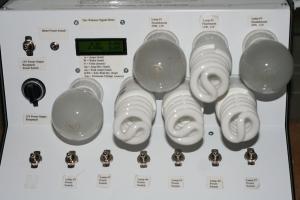The University of Northern Iowa has assembled a pedal power demonstration station which allows riders to directly compare the energy required to light 60-100 Watt incandescent bulbs with the energy to light 15-30W CFL bulbs. Using a bicycle, a 300 Watt DC permanent magnet motor, a deep cycle battery, and a metered switch box containing several types of light bulbs, the station allows students to quickly discover the increased efficiency of CFLs.  Bicycle powered light bulbs
Bicycle powered light bulbs
When comparing the UNI station to others: - UNI uses a permanent magnet generator rather than an alternator, and therefore voltage from the generator is not regulated. I do not yet see an advantage to using the generator (other than if you have one available), as unregulated voltage can quickly destroy light bulbs. - UNI uses a traditional mountain bike with 26" diameter wheels. If available, I would recommend using a more efficient bicycle. A road bike would be optimal, but a mountain bike with slick tires would also be an improvement - both in noise and efficiency.  - UNI has a very nice display box, containing a voltage and watt meter. They have several 12V light bulb sockets and a set of very nice (expensive) 12V light incandescent and CFL bulbs. As a result, there is no energy lost through the inverter (which may only be 80-90% efficient). However, the inverter does allow 110/120VAC loads (e.g., laptop, small television, radio), a nice feature for those looking for more than a demonstration.
- UNI has a very nice display box, containing a voltage and watt meter. They have several 12V light bulb sockets and a set of very nice (expensive) 12V light incandescent and CFL bulbs. As a result, there is no energy lost through the inverter (which may only be 80-90% efficient). However, the inverter does allow 110/120VAC loads (e.g., laptop, small television, radio), a nice feature for those looking for more than a demonstration.
